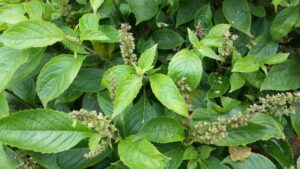African yam bean (Ijiriji) is a special, underutilized legume that produces both edible beans and tubers on the same plant.
It is native to Ethiopia but has spread to other countries like Egypt, Nigeria, and Ghana. In Nigeria, it is mainly cultivated for its bean seeds (ijiriji) while it is grown for its tubers in Ghana, Togo, Zimbabwe and some other countries.
The African yam bean seeds is incredibly healthy. Adding it to your diet can help prevent diabetes, obesity, and cancer.
Other names for it include; Sphenostylis stenocarpa (Family: Fabaceae), yam pea (English), Ijiriji, Okpu dudu, Sese, Girigiri, and Pempo.
Nutrition facts
Although the African yam bean has been eaten in Africa for years, scientists are just beginning to study the nutrition content of this plant.
The bean occurs naturally in red, brown, and black colors. It is an excellent source of iron, zinc, and protein (29%) – higher than cowpeas (20%) and bambara nuts (25%). [1]
While the white-fleshed tuber part is higher in protein than sweet potatoes, yam, and cassava.
The yam bean is rich in protein, carbohydrates, but low in fats. The following are nutrients found in 100 grams of ground bean seed [1]:
- Energy: 392 Kilocalories
- Protein: 22 grams (g)
- Carbohydrates: 53 g
- Fiber: 6 g
- Fats: 3 g
- Zinc: 8 milligrams (mg)
- Iron: 9 mg
- Selenium: 150 mg
The bean was also found to be rich in phenols, flavonoids, and other important antioxidants beneficial to health.
Health Benefits
The following are the possible health benefits of eating African yam bean (Ijiriji):
1. Rich in protein
Protein plays a vital role in building and repairing cells in your body. Amino acids are the building blocks of protein and yam pea is particularly high in the important amino acid “lysine”.
Lysine is almost deficient in most grains like rice, sorghum, and millet. So it is essential to combine lysine-rich foods with grains. [2]
Eating a diet rich in protein helps to prevent malnutrition in people from local income areas.
This delicious bean also makes an excellent source of protein for vegans and vegetarians.
2. Good for diabetics

African yam bean is a low glycemic index food because it is rich in fiber and resistant starch.
Low glycemic index foods are rich in resistant starch and cause food to be slowly digested – causing a smaller rise in blood glucose levels.
One study found that replacing rice with beans, reduced blood glucose levels in both diabetic and non-diabetic participants. [3]
Another study found that consuming a diet rich in legumes prevented type 2 diabetes in older adults at high risk of cardiovascular disease. [4]
3. Prevents cancer
African yam bean is rich in flavonoids and other antioxidants that are known to prevent cancer.
They occur naturally in different colors, and colored beans are known to possess greater antioxidant activity than white beans. [5]
Antioxidants help the body fight free radicals that can cause cancer and other metabolic diseases.
Also, an earlier study found that the dietary fiber content of beans may play a role in reducing the risk of colorectal cancers. [6]
4. Promotes weight loss
The African yam bean is low in fats but high in fiber making it an ideal weight-loss food.
The high fiber content of yam peas promotes a feeling of satiety, helps you stay full for longer periods, and prevents overeating.
One study in thirty-five obese men placed on a high-legume and protein diet found that there was a greater weight reduction in eight weeks when compared to other diets. [7]
Related: 50 African foods to help you lose weight quickly
5. Lower cholesterol levels
People who consume yam peas or legumes regularly may be less likely to die of a heart attack or other cardiovascular problem since they are high in fiber.
Consumption of a high-fiber bean diet has been associated with a decrease in levels of low-density lipoproteins (LDL) cholesterol – a risk factor for coronary heart disease and stroke. [8]
6. Promotes digestive regularity
The high fiber content of African yam bean ensures easy digestion and prevents constipation.
Also, the resistant starch content of beans improves gut health by promoting the growth of good bacteria that is beneficial to the immune system. [9]
Related: 15 best African foods rich in dietary fiber
7. Gluten-free alternative
People with celiac disease do not consume gluten-rich foods like wheat and barley.
However, the African yam bean is gluten-free and should provide a good alternative for people sensitive to gluten.
You can combine yam pea flour with other gluten-free flours like tapioca or rice flour.
How to prepare African yam bean (Ijiriji)
Like other common legumes, African yam bean cannot be eaten raw because it contains some anti-nutritional compounds that can cause stomach problems. So before eating, it has to be prepared properly with any of the following methods [10]:
Boiling
Before boiling, the yam pea should be steeped in hot water for 24 hours to reduce cooking time and break down toxic compounds. Then boil for about 4 hours until it is done. Once it is soft enough, it is ready to eat!
Roasting
Roasting is a great way to add depths of flavor to yam pea. In the eastern part of Nigeria, the bean seeds are roasted until the seed browns slightly, then they are eaten as a snack with palm kernels.
Fermentation
Fermentation is another popular method used to prepare the African yam bean (Ijiriji). The bean seeds are stepped into clean water with other grains like (maize, millet, sorghum) and allowed to ferment for about three days.
The water is changed every day to avoid decay or bad odor. After the allotted time, the mixture is then milled and used to prepare different traditional dishes.
Milling
Before milling, the bean is sorted to remove stones and other foreign materials. Then it is soaked in water for about 24 hours, dehulled, and dried for 3 days or until completely dry. Finally, the dried bean is milled into flour using a dry blender.
Culinary uses of African yam bean

Since the African yam bean is rich in protein (amino acids) and nutrients, it is often used to fortify or enrich other low protein foods.
The following are ways you can add it to your diet [10]:
- Baked goods: Yam pea flour is often combined with other cereal flours (wheat, corn) to prepare delicious biscuits, cookies, snacks, and noodles. It improves their taste, adds more protein, and nutrients.
- Porridge: The cooked bean can be prepared into a porridge that is eaten as a dip, curry, or side dish.
- Weaning food: African yam bean helps to fortify a popular weaning and breakfast food called “Ogi”. It adds more protein and improves the taste of this healthy gruel.
Related: 10 health benefits of Ogi (Akamu) for you and your baby.
- Complementary foods: The yam pea flour is mostly added to local diets like fufu, amala, and tuwo. The bean increases the taste and protein content of these carbohydrates-rich foods usually prepared with cassava or yams.
Possible side effects
Like other legumes, consumption of African yam bean may cause gas and stomach discomfort in some people.
This is usually due to the presence of nondigestible carbohydrates, called oligosaccharides.
However, research has found that discarding the soaking and cooking water may help to remove some of these flatulence-causing compounds. [11]
Before you add beans to your diet, increase the amount gradually to give your gut time to adjust.
The bottom line
African yam bean is incredibly rich in nutrients and antioxidants that can prevent several metabolic disorders.
Its rich protein content is ideal for poor communities suffering from malnutrition.
Besides, African yam bean can keep you full for longer periods, making it an excellent food for weight loss.
Therefore, enrich your meals and pastries with yam peas and start enjoying today!
- Baiyeri, S. et al. (2018). Evaluation of the nutritional composition of the seeds of some selected African yam bean (Sphenostylis stenocarpa Hochst Ex. A. Rich (Harms)) accessions. Agro-Science. 17. 37. 10.4314/as.v17i2.5.
- Rutherfurd, S. et al. (2012). Available lysine and digestible amino acid contents of proteinaceous foods of India. The British journal of nutrition. 108. S59-S68. 10.1017/S0007114512002280.
- Thompson, S.V. et al (2012) Bean and rice meals reduce postprandial glycemic response in adults with type 2 diabetes: a cross-over study. Nutr J11, 23. https://doi.org/10.1186/1475-2891-11-23
- Becerra-Tomás, Nerea et al. “Legume consumption is inversely associated with type 2 diabetes incidence in adults: A prospective assessment from the PREDIMED study.” Clinical nutrition (Edinburgh, Scotland) vol. 37,3 (2018): 906-913. doi:10.1016/j.clnu.2017.03.015
- Madhujith, T. et al. (2005). Antioxidant activity of common beans (Phaseoul vulgaris L). Journal of Food Lipids. 11. 220 – 233. 10.1111/j.1745-4522.2004.01134.x.
- Lanza, Elaine et al. (2006) “High dry bean intake and reduced risk of advanced colorectal adenoma recurrence among participants in the polyp prevention trial.” The Journal of nutrition vol. 136,7: 1896-903. doi:10.1093/jn/136.7.1896
- Abete, Itziar et al. (2009) “Legume-, fish-, or high-protein-based hypocaloric diets: effects on weight loss and mitochondrial oxidation in obese men.” Journal of medicinal food vol. 12,1: 100-8. doi:10.1089/jmf.2007.0700
- Anderson, J W et al. (1990) “Serum lipid response of hypercholesterolemic men to single and divided doses of canned beans.” The American journal of clinical nutrition vol. 51,6: 1013-9. doi:10.1093/ajcn/51.6.1013
- Monk, Jennifer M et al. (2017) “Navy and black bean supplementation primes the colonic mucosal microenvironment to improve gut health.” The Journal of nutritional biochemistry vol. 49: 89-100. doi:10.1016/j.jnutbio.2017.08.002
- Toyosi T. et al. (2020): “The prospects of African yam bean: past and future importance”. Published by Elsevier Ltd.
- Vidal-Valverde, C et al. “Changes in the carbohydrate composition of legumes after soaking and cooking.” Journal of the American Dietetic Association vol. 93,5 (1993): 547-50. doi:10.1016/0002-8223(93)91814-7
Get new free and exclusive health tips delivered straight to your inbox!



